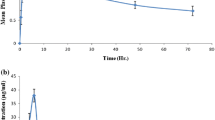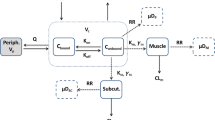Summary
Single dose studies were performed in six young and six elderly nonsmokers using lignocaine as a model drug with high intrinsic clearance. Subjects received lignocaine 250 mg orally and 50 mg intravenously in random order and drug concentrations in blood and plasma were measured for up to 8 h after dose. Protein binding was estimated at 37 °C by equilibrium dialysis. Indocyanine green kinetics were also calculated in each individual following 0.15 mg/kg intravenously.
Bioavailability of lignocaine was greater in the elderly but there was no apparent difference in the rate of absorption. Intrinsic clearance of lignocaine was lower in the aged. Elimination half-life was longer in the elderly but there was no significant difference in apparent volume of distribution or systemic clearance of lignocaine. Plasma clearance of indocyanine green showed no correlation with systemic lignocaine clearance and was lower in the aged subjects. Blood/plasma lignocaine ratio was less than unity in both groups. Binding of lignocaine to plasma proteins showed concentration-dependence and was higher in the geriatric group. Maximum binding capacity of lignocaine was greater in the elderly but the binding affinity did not significantly change with age.
Greater oral bioavailability of drugs like lignocaine may produce higher plasma concentrations in the elderly. Unlike indocyanine green, the systemic clearance of lignocaine was unaltered by age in this group of non-smokers. The protein-binding of lignocaine, like many other basic drugs, is increased in elderly subjects.
Similar content being viewed by others
References
Nies AS, Shand DG, Wilkinson GR (1976) Altered hepatic blood flow and drug disposition. Clin Pharmacokinet 1: 135–155
Keenaghan JB, Boyes RN (1972) The tissue distribution, metabolism and excretion of lignocaine in rats, guinea pigs, dogs and man. J Pharmacol Exp Ther 180: 454–463
Perruca E, Richens A (1979) Reduction of oral bioavailability of lignocaine by induction of first-pass metabolism in epileptic patients. Br J Clin Pharmacol 8: 21–31
Boyes RN, Scott DB, Jebson PT, Godman MJ, Julian DG (1971) Pharmacokinetics of lignocaine in man. Clin Pharmacol Ther 12: 105–115
Stenson RE, Constantino RT, Harrison DC (1971) Inter-relationship of hepatic blood flow, cardiac output and blood levels of lignocaine in man. Circulation 43: 205–211
Wilkinson GR, Shand DG (1975) A physiological approach to hepatic drug clearance. Clin Pharmacol Ther 18: 377–390
Huet M, Lelorier J, Pomier G, Marleau D (1979) Bioavailability of lignocaine in normal volunteers and cirrhotic patients. Clin Pharmacol Ther 25: 229–230
Sherlock S, Bearn AG, Billing BH, Patterson JCS (1950) Splanchnic blood flow in man by the bromosulphalein method: The relation of peripheral plasma bromosulphalein level to the calculated flow. J Lab Clin Med 35: 923–932
Castleden CM, George CF (1979) The effect of ageing on the hepatic clearance of propranolol. Br J Clin Pharmacol 7: 49–54
Nation RL, Vine J, Triggs EJ, Learoyd B (1977) Plasma levels of chlormethiazole and two metabolites after oral administration to young and aged human subjects. Eur J Clin Pharmacol 12: 137–145
Vestal RE, Wood AJJ, Branch RA, Shand DG, Wilkinson GR (1979) Effects of age and cigarette smoking on propanolol disposition. Clin Pharmacol Ther 26: 8–15
Caesar J, Shaldon S, Chiandussi L, Guevara L, Sherlock S (1961) The use of indocyanine green in the measurement of heaptic blood flow and as a test of hepatic function. Clin Sci 21: 43–57
Zito RA, Reid PR (1978) Lignocaine kinetics predicted by indocyanine green clearance. N Engl J Med 298: 1160–1163
Braithwaite RA, Heard R, Snape A (1978) Plasma protein binding of maprotiline in geriatric patients — influence of alpha1-acid glycoprotein. Br J Clin Pharmacol 6: 448p-449p (abstract)
Verbeeck RK, Cardinal J-A, Wallace SM (1984) Effect of age and sex on the plasma binding of acidic and basic drugs. Eur J Clin Pharmacol 27: 91–97
Paxton JW, Briant RH (1984) Alpha1-acid glycoprotein concentrations and propranolol binding in elderly patients with acute illness. Br J Clin Pharmacol 18: 806–810
Branch RA, Shand DG, Wilkinson GR, Nies AS (1973) The reduction of lidocaine clearance by d,1-propranolol: an example of a haemodynamic drug interaction. J Pharmacol Exp Ther 184: 515–519
Scatchard G (1949) The attraction of proteins for small molecules and ions. Ann New York Acad Sci 51: 660–672
Tucker GT, Boyes RN, Bridenbaugh PO, Moore DC (1970) Binding of anilide type local anaesthetics in human plasma 1. Relationships between binding, physico-chemical properties and anaesthetic activity. Anaesthesiology 33: 287–303
Kelly JG, McGarry K, O'Malley K, O'Brien ET (1982) Bioavailability of labetalol increases with age. Br J Clin Pharmacol 14: 304–305
Rubin PC, Scott PJW, Reid JL (1981) Prazosin disposition in young and elderly subjects. Br J Clin Pharmacol 12: 401–404
Nation RL, Triggs EJ, Selig M (1977) Lignocaine kinetics in cardiac patients and aged subjects. Br J Clin Pharmacol 4: 439–448
Abernathy DR, Greenblatt DJ (1983) Impairment of lidocaine clearance in elderly male subjects. J Cardiovasc Pharmacol 5: 1093–1096
Cusson J, Nattel S, Lawand S, Talajic M (1984) Age-dependant lidocaine disposition after myocardial infarction. Clin Res 32: 240A (Abstract)
Drayer DE, Lorenzo B, Werns S, Reidenberg MM (1983) Plasma levels, protein binding, and elimination data of lidocaine and active metabolites in cardiac patients of various ages. Clin Pharmacol Ther 34: 14–22
Routledge PA, Shand DG, Barchowsky A, Wagner G, Stargel WW (1981) Relationship between alpha1-acid glycoprotein and lidocaine disposition in myocardial infarction. Clin Pharmacol Ther 3: 154–157
Holley FO, Ponganis KV, Stanski DR (1984) Effects of cardiac surgery with cardiopulmonary bypass on lidocaine disposition. Clin Pharmacol Ther 35: 617–626
Wood AJJ, Vestal RE, Wilkinson GR, Branch RA, Shand DG (1979) Effect of age and cigarette smoking on antipyrine and indocyanine green elimination. Clin Pharmacol Ther 26: 16–20
Bax NDS, Tucker GT, Woods HF (1978) Can lignocaine kinetics be predicted? Br J Clin Pharmacol 5: 441p (Abstract)
Williams RL, Blaschke TF, Meffin PJ, Melmon KL, Rowlands M (1976) Influence of viral hepatitis on the disposition of two compounds with high hepatic clearance: lignocaine and indocyanine green. Clin Pharmacol Ther 20: 290–299
Vestal RE, Wood AJJ, Branch RA, Wilkinson GW, Shand D (1978) Studies of drug disposition in the elderly using model compounds. In: Kitani K (ed) Liver and aging. Elsevier/North-Holland Biomedical Press, pp. 343–357
Routledge PA, Barchowsky A, Bjornsson TD, Kitchell BB, Shand DG (1980) Lidocaine plasma protein binding. Clin Pharmacol Ther 27: 347–351
Piafsky KM, Borga O, Odar-Cederlof I, Johansson C, Sjoquist F (1978) Increased plasma protein binding of propranolol and chlorpromazine mediated by disease-induced elevations of plasma alpha1-acid glycoprotein. N Engl J Med 299: 1435–1439
Goolkosian DL, Slaughter RL, Edwards DJ, Lalka D (1983) Displacement of lidocaine from serum alpha1-acid glycoprotein binding sites by basic drugs. Eur J Clin Pharmacol 25: 413–417
Davis D, Grossman SH, Kitchell BB, Shand DG, Routledge PA (1980) Age-related changes in the plasma protein binding of lidocaine and diazepam. Clin Res 28: 234A (Abstract)
Sager G, Hansteen V, Aakesson I, Jacobsen S (1981) Effect of heparin on serum binding of propranolol and chlorpromazine mediated by disease-induced elevations of plasma alpha1-acid glycoprotein. N Engl J Med 299: 1435–1439
Bendayan R, Pieper JA, Stewart RB, Caranosus GJ (1984) Influence of age on serum protein binding of propranolol. Eur J Clin Pharmacol 26: 251–254
Prescott LF, Adjepon-Yamoah KK, Talbot RG (1976) Impaired lignocaine metabolism in patients with myocardial infarction and cardiac failure. Br Med J 1: 939–941
Thompson PD, Melmon KL, Richardson JA, Cohn K, Steinbrunn W, Cudihee R, Rowlands M (1973) Lidocaine pharmacokinetics in advanced heart failure, liver disease and renal failure in humans. Ann Intern Med 78: 499–508
Forrest JAH, Finlayson NDC, Adjepon-Yamoah KK, Prescott LF (1977) Antipyrine, paracetamol and lignocaine elimination in chronic liver disease. Br Med J 1: 1380–1387
Lelorier J, Grenon D, Latour Y, Caille G, Dumont G, Brosseau A, Solignac A (1977) Pharmacokinetics of lidocaine after prolonged intravenous infusion in uncomplicated myocardial infarction. Ann Intern Med 87: 700–702
Pfeifer HJ, Greenblatt DJ, Koch-Weser J (1976) Clinical use and toxicity of intravenous lidocaine. A report from the Boston Collaborative Drug Surveillance Program. Am Heart J 92: 168–173
Routledge PA, Stargel WW, Barchowsky A, Wagner GS, Shand DG (1982) Control of lidocaine therapy: New perspectives. Ther Drug Monit 4: 265–270
Author information
Authors and Affiliations
Rights and permissions
About this article
Cite this article
Cusack, B., O'Malley, K., Lavan, J. et al. Protein binding and disposition of lignocaine in the elderly. Eur J Clin Pharmacol 29, 323–329 (1985). https://doi.org/10.1007/BF00544089
Received:
Accepted:
Issue Date:
DOI: https://doi.org/10.1007/BF00544089




